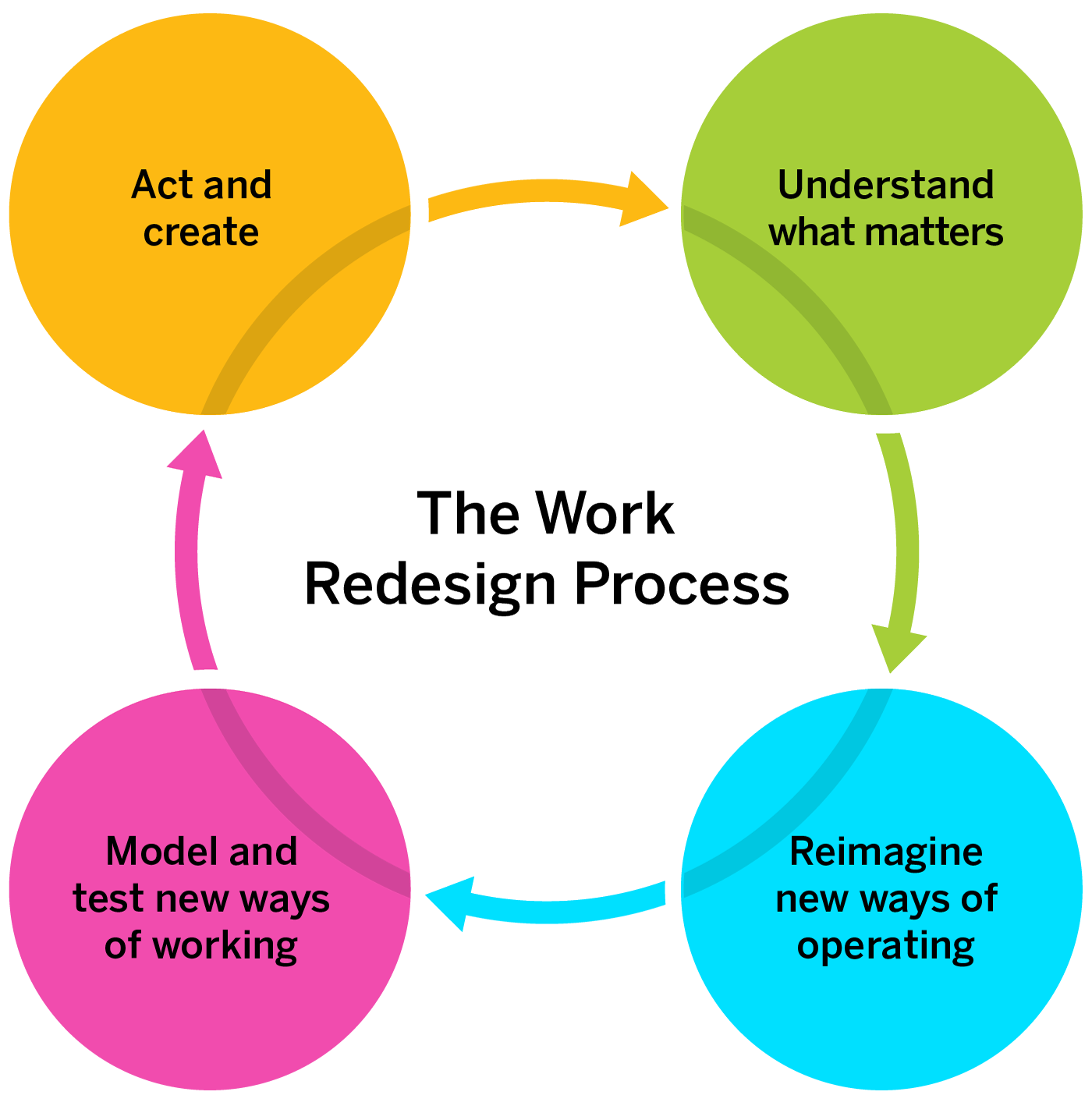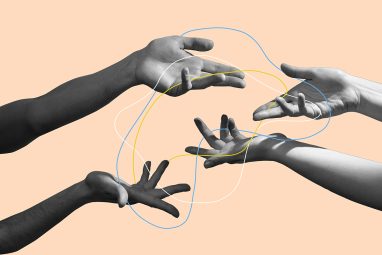The Four-Step Process for Redesigning Work
Fear of failure weighs heavily on many leaders tasked with managing new workplace expectations. Seeing the challenge as a process is the way forward.
Topics
News
- Identity-based Attacks Account for 60% of Leading Cyber Threats, Report Finds
- CERN and Pure Storage Partner to Power Data Innovation in High-Energy Physics
- CyberArk Launches New Machine Identity Security Platform to Protect Cloud Workloads
- Why Cloud Security Is Breaking — And How Leaders Can Fix It
- IBM z17 Mainframe to Power AI Adoption at Scale
- Global GenAI Spending to Hit $644 Billion by 2025, Gartner Projects

Since the beginning of the pandemic, we’ve expanded our workplace skills, workplace assumptions, and workplace habits. But after the initial excitement of discovering new ways of working, deep fears are emerging.
One executive in a major food company asked me, “Is it fair that office workers are now experimenting with working from home three days a week while factory workers are still in place doing their normal shifts?” There’s a growing worry as well that hybrid schedules will result in a fall in productivity, particularly employees’ levels of cooperation and creativity. As I heard from one executive, “We know that our open-plan offices were noisy and distracting, but they did create a space for people from across groups to meet up.”
These fears have only increased as the Great Resignation has left leaders hypersensitive to issues of retention and unsure what accommodations, if any, will attract and keep talent. They are also apprehensive about what their competitors are doing.
This has a ripple effect: Because of the fear of failure, I’ve seen leaders begin to stumble on issues of inclusion, belonging, and identity. Rather than being bold and adopting an experimental mindset, they are falling back to familiar ways of operating and becoming less empathic to what others want. When we fear failure, we retreat to the known.
But some leaders have been able to confront these worries. I’ve worked closely with executive teams of more than 30 companies since the beginning of the pandemic. Tackling uncertainties begins by seeing these challenges not simply as binary judgments (for example, office or home; full time or part time). Instead, by seeing their task as managing a process of redesign and change, senior leaders can address legitimate fears about the complexity of getting the employee proposition right and create a practice of embracing change that is fair and inclusive.
A Way Forward Through Redesign
When leaders are feeling anxiety and fear, making top-down judgments is natural. But this works only when a leader knows exactly what to do — and in the current moment, most do not. On the other hand, leaving decisions in the hands of individual managers inevitably leads to feelings of mistrust and bias across employee groups, something I have seen in many organizations.
There is a widespread feeling that the way organizations work is in need of a structural overhaul, and that the task of moving forward needs to be worked out by more people than just an organization’s top leadership. Leaders who have confronted their fears and set about this task of overhaul have done it by moving through four crucial steps: understanding people, networks, and jobs; reimagining how work gets done; modeling and testing redesign ideas against core principles; and ensuring the overhaul sticks by taking action widely. (See “The Work Redesign Process.”)
The Work Redesign Process
This design process engages leaders in questions about productivity and capabilities. It provides an opportunity to create a way of working that fully resonates with an organization’s unique purpose and values.

Source: Redesigning Work, by Lynda Gratton
Let’s take a deeper dive into how these leaders have gone about this.
Understand what matters. One fear of leaders is that changing work practices, like working from home, will reduce productivity. Will people work less hard at home? Will they suffer from a lack of in-person collaboration?
To confront this fear, a leader needs to understand with precision what matters: for example, where and how productive work takes place, what people want, and how knowledge flows. That was the starting point for Dario Kosarac, who heads up rewards at CPP Investments, a global investment management organization that invests the assets of the Canadian Pension Plan. He discovered that during the pandemic, as some people worked from home, the fund reported its highest-ever annual returns, of 20.4%. To understand why, he and his team dived into past and current performance data analytics and increased their understanding of the key tasks of significant jobs.
They found that in many crucial tasks, what drove productivity was employees’ capacity to focus, in terms of individual thinking, analyzing, and writing. It turned out that for these people, being out of a busy office during lockdown was a plus. As Kosarac put it, “There are productivity losses when people are in the office with colleagues coming by their desk every two minutes.” So, as the team at CPP went about redesigning work, it could plan for people working outside of the office without the fear of productivity loss, and indeed plan for probable productivity gains.
Because work, people, and knowledge flow differ across companies, it is no surprise that there are no one-size-fits-all answers. That was clear from my conversations with teams at Arup, a design group that has more than 15,000 specialists working in projects spanning 140 countries. When thinking about redesigning work, they came to a very different conclusion. They found that while focus was indeed important, tasks requiring cooperation were more of a significant driver of productivity. As Arup principal Joe Correnza told me, “Bringing ideas from across all our disciplines is crucial for us. In the office, we have engineers, designers, planners, technical specialists, and consultants. We want them to talk to each other and bounce ideas off each other.” This leadership clarity of understanding meant that going forward Arup could be clear that an office-based way of working would maximize highly valued cooperative behavior.
Reimagine new ways of operating. At CPP, the team’s understanding of focus as a key driver of productivity reduced their fears about pushing for an office-based way of working and enabled them to be imaginative and bold. They began creating opportunities for some employees to work anywhere for three months. This kind of accommodation might not work in all companies, but the link with the purpose of CPP was strong. As Kosarac told me, “Across the span of a whole career, [three months] is a very small part of their working life with us.” This long-term thinking mirrors CPP’s business strategy. “The investment horizon is the next quarter century,” said Kosarac, and a long-term focus is implicit in the model of work. “We don’t want to be a place that exploits and burns people out. We want to keep our colleagues engaged, motivated, and balanced.”
I saw a similar boldness of imagination in how Unilever reimagined the employee contract — the set of promises that employers make to their people. Placid Jover, at the time the vice president of human resources across Latin America, explained a dream “to increase access to in-demand skills and bring greater flexibility to our resourcing options.” To do that, the conglomerate reimagined how to enable employees to work for Unilever while also engaging in other activities such as starting a business, traveling, or caring for a family member. In this model, called U-Work, some employees receive a monthly retainer and earn assignment pay. Importantly, they also get pension support and access to health insurance.
“We wanted to fill the white space between being a full-time employee and being a contractor or agency worker from a third-party organization,” said Jover. “We wanted to move from ‘owning’ talent to ‘accessing’ talent.”
Model and test new ways of working. A real fear for leaders is that new models of work might be misaligned to the company’s purpose or business strategy. Those who have confronted this fear have explicitly defined their guiding principles and pressure tested new ideas against them. Aoife Fitzmaurice, who leads transformation at accounting software provider Sage, faced this task after the company moved its 13,000 employees to being fully virtual in the early months of the pandemic. Once leadership realized the company could operate effectively virtually, Fitzmaurice had to figure out what a hybrid way of working could look like longer term.
In a series of workshops, leaders hammered out four principles to test their new hybrid model of work. They asked how it would impact customer centricity, fairness, human connections, and a spirit of being experimental. For each principle, nonnegotiable “red lines” were established. For example, these leaders were explicit about what being customer-centric meant and how hybrid work would have to align to changing customer needs.
The fourth principle was also important, Fitzmaurice says. “There was nervousness in the system that we would make the wrong choice. So it was crucial that people felt they could be bold and courageous.”
Act and create. One legitimate concern many employees have expressed is that new models of work may end up becoming fads that are never really embedded into the culture of the company or they’ll be discarded at the first sign of a recession or cost cutting. I’ve discovered that new ways of working are strengthened by a leader’s role modeling; supported by the pivotal role of managers; and launched through a process of co-creation that engages employees in making design choices and defining accountabilities.
At Sage, the process of redesigning work began with Fitzmaurice and her colleagues running a series of virtual workshops with a multidisciplinary group of employees to understand their needs and aspirations. After looking closely at jobs and the way knowledge flows through the organization, they took the case for change to the leadership team, including CEO Steve Hare. Workshops defining the four principles deepened engagement and support throughout the company.
Once the basic model was agreed upon — some workers being fully remote, others working hybrid, and a small number either full time in the office or full time in the field — engaging managers was crucial. A series of workshops with them helped create a managerial playbook. At the same time, talking points were developed for leaders to describe how these new work models would positively impact talent attraction and retention while supporting the strategic aim of the business.
Finally, individual managers circled back to their teams to make agreements on details such as when employees would work together in the office and when they would engage in focused work at home. The managers also reached out across their peer networks to support and learn from each other.
There is no doubt that leaders are legitimately fearful of failing in this crucial moment. But they can address these fears by seeing this challenge as a design process to work through as a team.
I urge business leaders to ask themselves three questions: Where are you now on the journey of redesigning work? Are there steps you need to reengage with in a more purposeful manner? And are you clear about what your biggest priorities are? The actions you take now will create your signature model of work and define the deal that you are making with your employees and your customers.





